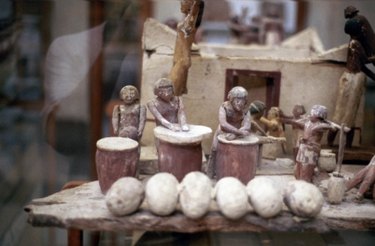Things You'll Need
Shoebox with separate lid
Scissors or utility knife
Ruler
Lightweight cardboard, such as a recycled manila folder or a gift box
White paint
1 inch or smaller paintbrush

The ancient Egyptians built most of their houses out of mud that was mixed with straw or pebbles and formed into bricks using molds, according to Minnesota State University's Egypt website. River mud offered a building material that helped insulate homes from the desert heat. Homes of workers and wealthy Egyptians included a courtyard and underground food storerooms. Houses usually were one or two stories tall and flat on top. The roof provided additional living space and allowed the Egyptians a place to cook without heating up the house.
Step 1
Remove the lid from a shoebox and keep it nearby. Turn the shoebox upside down. The shoebox bottom works as the flat roof of a typical Egyptian house.
Video of the Day
Step 2
Draw two narrow rectangular windows near the roof on each of the long sides of the box. For example, draw 1-by-2-inch rectangles, 1 inch below the roof.
Step 3
Draw a larger rectangle on one end of the shoe box for a door -- a narrow end of the box, not one of the long walls with the windows. Make the door three times the width of the windows or 3 inches or more depending on the size of the shoebox, For a small box, make the door 2 inches wide. Make the bottom of the door 1 inch from the bottom of the wall -- keeping in mind the bottom of the shoebox is the roof. Ancient Egyptian houses had raised doors to help keep out dirt and sand.
Step 4
Cut the door rectangle on the bottom, the top and on the left-hand side -- the left side of the door as you hold the box in front of you. Leave the right side of the door attached to the house to serve as the hinge. Open the door and crease it along the line you drew by folding it all the way to the right, against the box.
Step 5
Cut out the four window rectangles. Remove the window rectangles completely.
Step 6
Cut a piece of lightweight cardboard to fit in the bottom of the door and serve as a ramp. A ramp made a convenient way for ancient Egyptians to reach their raised doorways, the same way that ramps at public buildings allow people in wheelchairs to enter buildings. Draw a rectangle 2 or 3 inches wide -- depending on the width of your door -- and 5 inches long. Cut out the rectangle.
Step 7
Fold 1/2-inch of one narrow end of your ramp at a 90-degree angle. This creates a tab to glue the ramp to the bottom of the door. Apply glue to the side of the tab that faces the underside of the ramp. Insert the tab inside the bottom of the door and press the tab against the bottom of the inside door with your finger. Pinch the end of the ramp at the bottom of the door and hold for a slow count of 30 to help the glue take hold.
Step 8
Cut a 2-inch-wide strip of lightweight cardboard 3 inches longer than the shoebox is tall. For example, if the shoebox is 4 inches tall from the bottom of the wall to the top of the roof, make a mark 7 inches from the end of a piece of lightweight cardboard.
Step 9
Draw a ladder on the strip of cardboard. Draw two parallel lines, each 1/4-inch from a long edge, so it looks like train tracks. Draw two 1/4-inch lines for each rung of the ladder, with each rung 1/2-inch apart. Make the last rung 1 inch from the top to leave handholds, like a firetruck ladder.
Step 10
Cut out the ladder. Prop the ladder with the top of it against the roof to the left of the door. Apply a drop of glue to the back of the ladder on each side where it touches the top of the wall. Hold the ladder against the top of the wall to help the glue stick.
Step 11
Turn the shoebox lid upside down. Cut open two corners on one narrow end of the lid. A cut right in the corner allows you to push the lip around the lid flat on one end. Apply a line of glue along the inside edges of the lid on the back half of the lid. Set your Egyptian model house on the lid so that half of the lid extends in front of the door, forming the house's courtyard.
Step 12
Paint the Egyptian model house white, to represent the plaster the Egyptians applied to the outside of a finished house.
Tip
If your ruler is 1-inch wide, hold it in place and trace it to make a 1-inch-wide window, and then connect the lines to finish the rectangle.
Warning
Handle scissors with care. Cardboard can be tough to cut. Allow plenty of time to build your project so you won't be in a rush.
Video of the Day